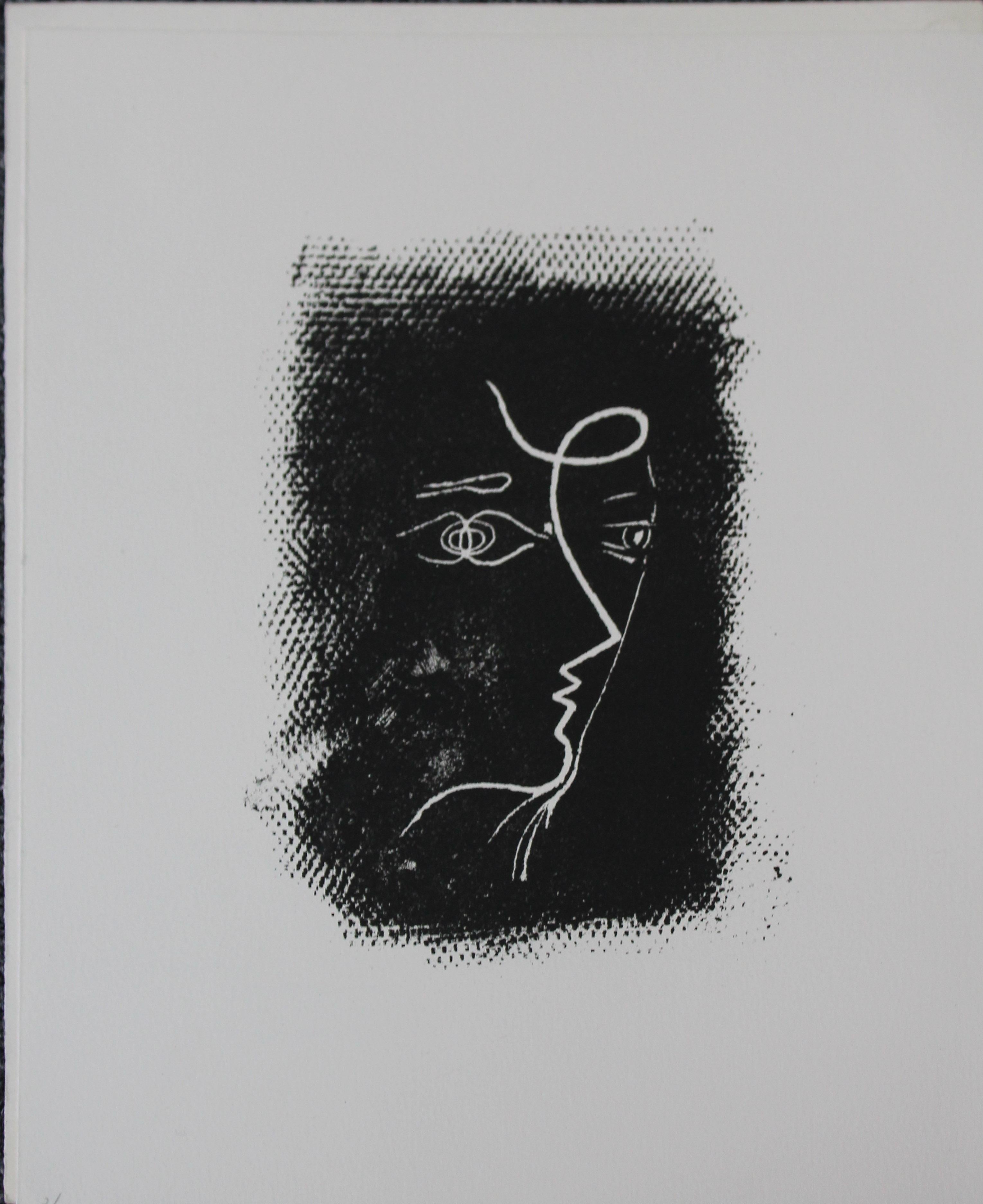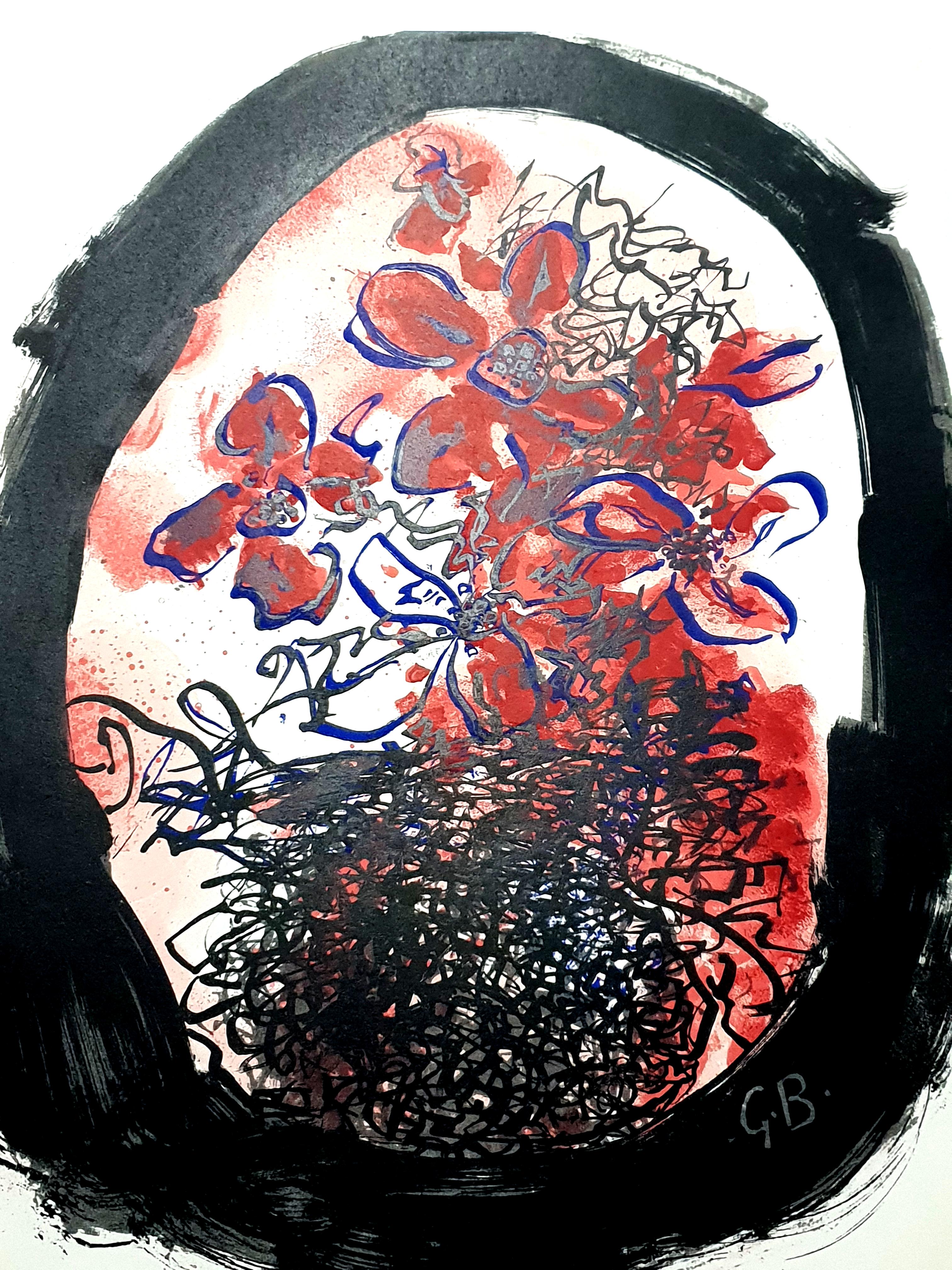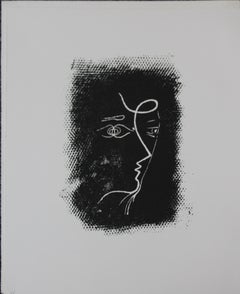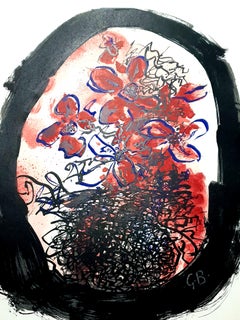Items Similar to Cubist Profile in Grey - Original lithograph, Signed (Vallier #153)
Want more images or videos?
Request additional images or videos from the seller
1 of 6
George BraqueCubist Profile in Grey - Original lithograph, Signed (Vallier #153)
$927.87
£708.40
€790
CA$1,310.09
A$1,437.66
CHF 750.90
MX$17,188.82
NOK 9,511.44
SEK 8,871.21
DKK 6,018.20
About the Item
Georges Braque (1882-1963)
Cubist Profile in grey
Original lithograph (Mourlot workshop)
Signed with the artist stamp
Numbered / 230
On Arches vellum 31 x 24 cm
REFERENCES :
- Catalog raisonne Mourlot #25
- Catalog raisonne Vallier #153
- Catalog raisonne Orozco #L469
INFORMATION : Created in 1955/60 by Braque to illustrate a book of correspondence with his friend Castor Seibel, this lithograph was published posthumously by Bordas / Mourlot according to the wishes of Georges Braque. Unable to sign the lithographs, they were coated, under the control of the Estate, with the artist's signature stamp.
Excellent condition
- Creator:George Braque (1882 - 1963, French)
- Dimensions:Height: 12.21 in (31 cm)Width: 9.45 in (24 cm)
- Medium:
- Movement & Style:
- Period:
- Condition:
- Gallery Location:Paris, FR
- Reference Number:1stDibs: LU464314718752
George Braque
Georges Braque was born on May 13, 1882, in Argenteuil-sur-Seine, France. Braque grew up in the town of Le Havre, and studied evenings at the Ecole des Beaux-Arts there from about 1897 to 1899. Braque left for Paris to study under a master decorator to receive his craftsman certificate in 1901. From 1902 to 1904, Braque painted at the Académie Humbert in Paris, where he met Marie Laurencin and Francis Picabia. By 1906, Braque's work was no longer Impressionist but Fauve in style. After spending the summer of that year in Antwerp with Othon Friesz, he showed his Fauve in the 1907 Salon des Indépendants in Paris. His first solo show was at Daniel-Henri Kahnweiler's gallery in 1908. From 1909 forward, Braque collaborated with Pablo Picasso in developing Cubism, and by 1911, their styles had become extremely similar. In 1912, they started to incorporate collage elements into their paintings and to experiment with the papier collé (pasted paper) technique. Their collaboration lasted until 1914. Braque served in the French army during World War I and was wounded in battle. Upon recovering, he developed a close friendship with the artist Juan Gris. After World War I, Braque's work became less and less schematic and more free. His fame grew in 1922 as a result of an exhibition at the Salon d'Automne in Paris. In the mid-1920s, Braque designed the decor for two Sergei Diaghilev ballets. By the end of the decade, he had returned to a more realistic interpretation of nature, although Cubist elements always remained present in his work. In 1931, Braque made his first engraved plasters and began to portray mythological subjects. His first important retrospective took place in 1933 at the Kunsthalle Basel. In 1937 he won First Prize at the Carnegie International in Pittsburgh. During World War II, Braque remained in Paris. His paintings at that time, primarily still lifes and interiors, became more somber. In addition to paintings, Braque also made lithographs, engravings, and sculpture. From the late 1940s, he treated various recurring themes, such as birds, ateliers, landscapes, and seascapes. In 1954, he designed stained-glass windows for the Varengeville Church. During the last few years of his life, Braque's ill health prevented him from undertaking further large-scale commissions, but he continued to paint, print lithographs, and design jewelry. He died on August 31, 1963, in Paris.
About the Seller
4.9
Platinum Seller
Premium sellers with a 4.7+ rating and 24-hour response times
Established in 2010
1stDibs seller since 2016
3,791 sales on 1stDibs
Typical response time: <1 hour
- ShippingRetrieving quote...Shipping from: Paris, France
- Return Policy
More From This Seller
View AllCubist Profile - Original lithograph, Signed (Vallier #153)
By George Braque
Located in Paris, IDF
Georges Braque (1882-1963)
Cubist Profile
Original lithograph (Mourlot workshop)
Signed with the artist stamp
Numbered / 230
On Arches vellum 31 x 24 cm
REFERENCES :
- Catalogue r...
Category
Mid-20th Century Cubist Portrait Prints
Materials
Lithograph
Two faces : The Lovers - Original lithograph - 399 copies
By Georges Braque
Located in Paris, IDF
Georges BRAQUE
Two Faces : the Lovers
Lithograph (Art-Litho workshop)
Printed signature in the plate
On Arches vellum 18 x 23" (58 x 45 cm)
INFORMATION: Limited edition of 399 cop...
Category
Late 20th Century Cubist Portrait Prints
Materials
Lithograph
Cubist Portrait - Stone lithograph, 1930
Located in Paris, IDF
Rodolphe-Théophile Bosshard
Cubist Portrait, 1930
Original stone lithograph
Printed signature in the plate
On Arches vellum 28 x 22 cm (c. 11 x 9 inch)
Excellent condition
Category
1930s Cubist Portrait Prints
Materials
Lithograph
Carmen, Cubist Face - Original Etching (Cramer #52)
By Pablo Picasso
Located in Paris, IDF
Pablo PICASSO
Carmen, Cubist Face , 1949
Original burin engraving (Atelier Lacourière, Paris)
Unsigned
On Montval wove paper 33 x 26 cm (12.9 x 10.2 in)
REFERENCES :
- Catalog rai...
Category
1940s Modern Portrait Prints
Materials
Etching
Portrait of a Woman in Profile, 1951 - Original Mourlot lithograph
By Françoise Gilot
Located in Paris, IDF
Françoise GILOT (1921)
Portrait of a Woman in Profile, 1951
Original lithograph
On Marais vellum 28 x 22.5 cm (c. 11 x 9 inches)
REFERENCES : Catalog raisonne "Stone Echoes, Origin...
Category
Late 20th Century Modern Portrait Prints
Materials
Lithograph
God of the River - Lithograph - 399 copies
By (after) Georges Braque
Located in Paris, IDF
MEDIUM : Lithograph
PRINTER : Atelier Art-Litho
EDITOR : Armand ISRAEL, Paris
SIGNATURE : Printed
LIMITED : 399 copies unumbered
PAPER : Arches vellum
SIZE : 18 x 23"
CONDITION : E...
Category
Late 20th Century Cubist Figurative Prints
Materials
Lithograph
You May Also Like
'Profil de Femme' From Souvenirs de Portraits d'Artistes
By Georges Braque
Located in Philadelphia, PA
Georges Braque
Profil de Femme
Original lithograph in colors on paper
Mourlout
Souvenirs de Portraits d'Artistes
1972
Category
1970s Prints and Multiples
Materials
Lithograph
Profil de Femme, Framed Modern Lithograph by Georges Braque
By Georges Braque
Located in Long Island City, NY
Artist: Georges Braque (after), French (1882 - 1963)
Title: Profil de Femme from Souvenirs de Portraits d'Artistes. Jacques Prévert: Le Coeur à l'ouvrage (M.25)
Year: 1972
Medium: Li...
Category
1970s Modern Figurative Prints
Materials
Lithograph
Georges Braque - Original Lithograph
By Georges Braque
Located in Collonge Bellerive, Geneve, CH
Georges Braque - Original Lithograph
1963
Dimensions: 32 x 24 cm
Andre Sauret, Monte Carlo
The father of Cubism
Three Cubist that distinguishes art historian periods were initiated and developed by Georges Braque: The Cubist Cézanne (1907-1909), Executive (1909-1912) and synthetic (1912-1922).
Post-Impressionist and fawn, Braque no longer adheres to the contingency of a decorative way or the other. Cézanne’s paintings exhibited at the Grand Palais during the retrospective of 1907 are a revelation: Cézanne sought and invented a pictorial language. In his footsteps, Braque went to the South with the reasons of the Master. He returned with Estaque landscapes and surprising Ciotat it keeps Cezanne geometric model and retains the “passages” continuity from one surface to another to create the sensation of “turning around” of the object represented. But he wants to go after the consequences of the vision of Cezanne. In his paintings Houses in L’Estaque (1908) it simplifies the volumes of houses, neglects detail by removing doors and windows: the plastic rhythm that builds the table. Large Nude , a masterpiece of the period, can be considered the first work of Cézanne cubism .
Systematizing and deepening Braque discoveries open the door analytical cubism. In 1909, his painting became more cerebral than sensual. The pattern is recreated in the two-dimensionality of the canvas, leaving aside any illusionistic perspective. In Still Life with Violin, objects are analyzed facets according to their characteristic elements, each facet referring to a particular view of the object. There are so many facets of points selected view: Table reflects the knowledge of the object and the ubiquity of the eye. Moreover, Braque is looking for the essence of the objects in the world rather than their contingency, which explains the absence of light source and use of muted colors (gray, ocher), contingent aspects of the object . But formal logic has stepped facets, erased any anecdote to the object and ultimately led to his painting a hermetic more marked on the edge of abstraction (see the series of Castle Roche-Guyon ).
Braque, anxious to keep the concrete and refusing at all costs that the logic of Cubism takes the paintings to abstract, reintroduced signs of reality in his paintings in 1912 marks the beginning of Synthetic Cubism. Historians speak of “signs of real” rather than reality because what interests Braque, this is not to put reality into a table, but to create a painting which, by its language, refers to the real. To do this, he invented two major techniques XX th century inclusions and contributions. The inclusions consist of painting objects that have no real depth, materials (wallpaper in Nature morte aux playing cards faux wood is a pictorial inclusion) or letters (calligraphic inclusion in Portuguese ), made first brush and a few months later stencil. Contributions are defined in contrast with the collage on canvas of foreign materials: glued or sand paper, sawdust, etc.. Regarding the collages, Braque used for the first time in September 1912 a piece of adhesive paper imitating faux wood Compote and Glass , then the packet envelope of tobacco Bock in 1912-1913, or an advertisement in Damier , 1913). Inputs and inclusions refer to an external object in the table, without “emulate” this object. Away from their appearances, objects are represented in closest essence of the objects in the real world sense.
This is also the time of Synthetic Cubism that Braque invented paper sculpture. There are, unfortunately, and no one is living proof of a photograph makes it possible to realize: Paper and paperboard.
Métamorphoses period(1961-1963).
In 1961, Georges Braque worked on a Greek head for the Louvre, which obsesses him, and he wishes to free his mind. He tried several times to bring out the paint and the result was unsatisfactory. He thinks the ultimate metamorphosis its Greek head projected in three dimensions. He calls in his studio of Baron Heger Loewenfeld, master lapidary, and he communicates his enthusiasm during the “fateful encounter.” Nine months later, in honor of the eighty years of Georges Braque, Heger Loewenfeld offers the Master of the ring Circe: the famous Greek head finally exorcised, carved in an onyx. Braque Loewenfeld then asked to identify other issues that haunt him.
From dated and signed by Georges Braque, Heger gouaches Loewenfeld shapes works in the fields of jewelery, lapidary art...
Category
1960s Modern Figurative Prints
Materials
Lithograph
Cubist Portrait
By George Braque
Located in OPOLE, PL
Georges Braque (1882-1963) - Cubist Portrait
Lithograph from 1939.
Dimensions of work: 35 x 26 cm
Publisher: Tériade, Paris.
The work is in Excellent condition.
Fast and secure ...
Category
1930s Surrealist More Prints
Materials
Lithograph
Profil Grec - original modern lithograph by classical modernist Georges Braque
By Georges Braque
Located in Hamburg, DE
"Profil Grec" is a color lithograph by famous French cubist artist Georges Braque, around 1962. This color lithograph on Veélin-Arches is from the editor Armand Israel and a limited...
Category
Mid-20th Century Cubist Still-life Prints
Materials
Paper, Lithograph
Pablo Picasso, "Portrait of Jacqueline, Right Profile, " original lithograph
By Pablo Picasso
Located in Chatsworth, CA
Pablo Picasso
"Portrait of Jacqueline, Right Profile"
Original Lithograph
The 3rd and final state, executed on zinc
Hand signed in pencil, numbered 21/50 from the edition of 50
Paper...
Category
1950s Modern Portrait Prints
Materials
Lithograph
More Ways To Browse
Vintage Breastfeeding Art
Warhol Cowboys And Indians
Warhol Queen Elizabeth
Warhol Shadow
Will Barnet Reflections
Alex Katz Black Hat
Andy Warhol Coa
Andy Warhol Eyes
Andy Warhol Judy Garland
Andy Warhol Muhammad Ali
Annie Leibovitz Patti Smith
Banksy Note
Dali Tarot Signed
Edgar Holloway
Henri Matisse Visages
Jacques De Bascher
Juan Carlos Breceda
Matisse Pompadour



